East Palestine residents want more time and information before deciding to accept $600M settlement
Some East Palestine residents want more time and more information before they have to decide by a deadline this week whether to accept their share of a $600 million class-action settlement with Norfolk Southern over last year's disastrous train derailment
ByJOSH FUNK Associated Press
Some East Palestine, Ohio, residents want more time and more information before they have to decide by a deadline this week whether to accept their share of a $600 million class-action settlement with Norfolk Southern over last year's disastrous train derailment.
But it's not clear whether the judge will rule on their motion before Thursday's deadline for people who live within 20 miles (32 kilometers) of the derailment to file a claim.
Residents who live within 10 miles (16 kilometers) of the Feb. 3, 2023, crash near the Ohio-Pennsylvania border also have to decide whether to accept up to $25,000 per person for personal injuries, although accepting that money will force them to give up the right to sue later if someone develops cancer or other serious illness because of the chemical exposure.
The amount residents can receive varies by how close they lived to the derailment, with people who lived within 2 miles receiving $70,000 for property damage. People who lived at the outer edge of the area might only receive a few hundred dollars.
One of the key complaints in the motion filed by attorney David Graham is that attorneys who represented residents in the lawsuit haven't disclosed any of the results of testing done around town by their own expert, Stephen Petty, who has testified in hundreds of lawsuits about contamination concerns, to determine the extent of the contamination caused when toxic chemicals spilled and burned after the derailment.
Some of the attorneys involved in the case promised residents in news interviews early on that Petty's data would be disclosed in court filings to lay out the impact on East Palestine. So Graham asked the judge to order that information to be released to try to address residents' concerns.
“Fast forward to their present, post-settlement posture, and class counsel and their PR machine have now forgotten all about their star testing expert, Petty,” Graham wrote.
Instead of Petty, the lawyers brought out a different expert at an online town hall meeting a couple weeks ago who told residents he didn’t think anyone in town would develop cancer as a result of the derailment. But Dr. Arch Carson didn’t make clear what data he relied on for that opinion other than a brief mention of tests from the Environmental Protection Agency.
Researchers studying the health of residents in the area and tracking respiratory problems, rashes and other ailments they are reporting say it may not be clear for years what the long-term implications of the derailment will be.
“I completely disagree with Dr. Arch Carson – there is no research data that suggest that his statement is correct,” said Dr. Erin Haynes, who is leading one of the main studies in town and is chair of the Department of Epidemiology and Environmental Health at the University of Kentucky College of Public Health.
Graham suggested that the plaintiffs' attorneys might be more interested in collecting their up to $180 million in legal fees than representing residents' interests.
The plaintiffs' lawyers didn't immediately respond to the motion Monday, but they have previously defended the settlement that was announced in the spring. They have said the settlement is bigger than any past derailment settlement that has been made public, and that the amount of time residents received to evaluate the deal is similar to other settlements.
Some residents have complained that the initial opt-out deadline in the lawsuit came less than a week after the National Transportation Safety Board held a hearing on its findings in the investigation.









